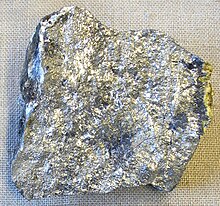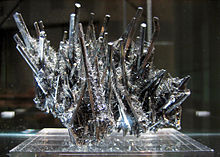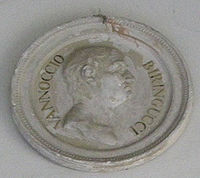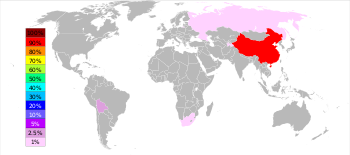Antimony
 | ||||||||||||||||||||||||||
| Antimony | ||||||||||||||||||||||||||
|---|---|---|---|---|---|---|---|---|---|---|---|---|---|---|---|---|---|---|---|---|---|---|---|---|---|---|
| Pronunciation | ||||||||||||||||||||||||||
| Appearance | silvery lustrous gray | |||||||||||||||||||||||||
| Standard atomic weight Ar°(Sb) | ||||||||||||||||||||||||||
| Antimony in the periodic table | ||||||||||||||||||||||||||
| ||||||||||||||||||||||||||
kJ/mol | ||||||||||||||||||||||||||
| Heat of vaporization | 193.43 kJ/mol | |||||||||||||||||||||||||
| Molar heat capacity | 25.23 J/(mol·K) | |||||||||||||||||||||||||
Vapor pressure
| ||||||||||||||||||||||||||
| Atomic properties | ||||||||||||||||||||||||||
Arabic alchemists (before AD 815) | ||||||||||||||||||||||||||
| Symbol | "Sb": from Latin stibium 'stibnite' | |||||||||||||||||||||||||
| Isotopes of antimony | ||||||||||||||||||||||||||
| ||||||||||||||||||||||||||
Antimony is a
China is the largest producer of antimony and its compounds, with most production coming from the Xikuangshan Mine in Hunan. The industrial methods for refining antimony from stibnite are roasting followed by reduction with carbon, or direct reduction of stibnite with iron.
The largest applications for metallic antimony are in
Characteristics
Properties


Antimony is a member of group 15 of the periodic table, one of the elements called pnictogens, and has an electronegativity of 2.05. In accordance with periodic trends, it is more electronegative than tin or bismuth, and less electronegative than tellurium or arsenic. Antimony is stable in air at room temperature, but reacts with oxygen if heated to produce antimony trioxide, Sb2O3.[9]
Antimony is a silvery, lustrous gray metalloid with a Mohs scale hardness of 3, which is too soft to mark hard objects. Coins of antimony were issued in China's Guizhou province in 1931; durability was poor, and minting was soon discontinued.[10] Antimony is resistant to attack by acids.
The only stable
Elemental antimony adopts a layered structure (space group R3m No. 166) whose layers consist of fused, ruffled, six-membered rings. The nearest and next-nearest neighbors form an irregular octahedral complex, with the three atoms in each double layer slightly closer than the three atoms in the next. This relatively close packing leads to a high density of 6.697 g/cm3, but the weak bonding between the layers leads to the low hardness and brittleness of antimony.[9]
Isotopes
Antimony has two stable isotopes: 121Sb with a natural abundance of 57.36% and 123Sb with a natural abundance of 42.64%. It also has 35 radioisotopes, of which the longest-lived is 125Sb with a half-life of 2.75 years. In addition, 29 metastable states have been characterized. The most stable of these is 120m1Sb with a half-life of 5.76 days. Isotopes that are lighter than the stable 123Sb tend to decay by β+ decay, and those that are heavier tend to decay by β− decay, with some exceptions.[18] Antimony is the lightest element to have an isotope with an alpha decay branch, excluding 8Be and other light nuclides with beta-delayed alpha emission.[18]
Occurrence

The abundance of antimony in the
Compounds
Antimony compounds are often classified according to their oxidation state: Sb(III) and Sb(V). The +5 oxidation state is more common.[21]
Oxides and hydroxides
Antimonous acid Sb(OH)
3 is unknown, but the conjugate base sodium antimonite ([Na
3SbO
3]
4) forms upon fusing sodium oxide and Sb
4O
6.[24] Transition metal antimonites are also known.[25]: 122 Antimonic acid exists only as the hydrate HSb(OH)
6, forming salts as the antimonate anion Sb(OH)−
6. When a solution containing this anion is dehydrated, the precipitate contains mixed oxides.[25]: 143
The most important antimony ore is stibnite (Sb
2S
3). Other sulfide minerals include pyrargyrite (Ag
3SbS
3), zinkenite, jamesonite, and boulangerite.[26] Antimony pentasulfide is non-stoichiometric, which features antimony in the +3 oxidation state and S–S bonds.[27] Several thioantimonides are known, such as [Sb
6S
10]2−
and [Sb
8S
13]2−
.[28]
Halides
Antimony forms two series of halides: SbX
3 and SbX
5. The trihalides SbF
3, SbCl
3, SbBr
3, and SbI
3 are all molecular compounds having trigonal pyramidal molecular geometry.
The trifluoride SbF
3 is prepared by the reaction of Sb
2O
3 with HF:[29]
- Sb
2O
3 + 6 HF → 2 SbF
3 + 3 H
2O
It is
4 and SbF2−
5. Molten SbF
3 is a weak electrical conductor. The trichloride SbCl
3 is prepared by dissolving Sb
2S
3 in hydrochloric acid:[30]
- Sb
2S
3 + 6 HCl → 2 SbCl
3 + 3 H
2S
Arsenic sulfides are not readily attacked by the hydrochloric acid, so this method offers a route to As-free Sb.

The pentahalides SbF
5 and SbCl
5 have trigonal bipyramidal molecular geometry in the gas phase, but in the liquid phase, SbF
5 is polymeric, whereas SbCl
5 is monomeric.[31] SbF
5 is a powerful Lewis acid used to make the superacid fluoroantimonic acid ("H2SbF7").
Oxyhalides are more common for antimony than for arsenic and phosphorus. Antimony trioxide dissolves in concentrated acid to form oxoantimonyl compounds such as SbOCl and (SbO)
2SO
4.[32]
Antimonides, hydrides, and organoantimony compounds
Compounds in this class generally are described as derivatives of Sb3−. Antimony forms antimonides with metals, such as indium antimonide (InSb) and silver antimonide (Ag
3Sb).[33] The alkali metal and zinc antimonides, such as Na3Sb and Zn3Sb2, are more reactive. Treating these antimonides with acid produces the highly unstable gas stibine, SbH
3:[34]
- Sb3−
+ 3 H+
→ SbH
3
Stibine can also be produced by treating Sb3+
salts with hydride reagents such as
Organoantimony compounds are typically prepared by alkylation of antimony halides with Grignard reagents.[36] A large variety of compounds are known with both Sb(III) and Sb(V) centers, including mixed chloro-organic derivatives, anions, and cations. Examples include triphenylstibine (Sb(C6H5)3) and pentaphenylantimony (Sb(C6H5)5).[37]
History

An artifact, said to be part of a vase, made of antimony dating to about 3000 BC was found at Telloh, Chaldea (part of present-day Iraq), and a copper object plated with antimony dating between 2500 BC and 2200 BC has been found in Egypt.[15] Austen, at a lecture by Herbert Gladstone in 1892, commented that "we only know of antimony at the present day as a highly brittle and crystalline metal, which could hardly be fashioned into a useful vase, and therefore this remarkable 'find' (artifact mentioned above) must represent the lost art of rendering antimony malleable."[39]
The British archaeologist Roger Moorey was unconvinced the artifact was indeed a vase, mentioning that Selimkhanov, after his analysis of the Tello object (published in 1975), "attempted to relate the metal to Transcaucasian natural antimony" (i.e. native metal) and that "the antimony objects from Transcaucasia are all small personal ornaments."[39] This weakens the evidence for a lost art "of rendering antimony malleable".[39]
The Roman scholar Pliny the Elder described several ways of preparing antimony sulfide for medical purposes in his treatise Natural History, around 77 AD.[40] Pliny the Elder also made a distinction between "male" and "female" forms of antimony; the male form is probably the sulfide, while the female form, which is superior, heavier, and less friable, has been suspected to be native metallic antimony.[41]
The Greek naturalist Pedanius Dioscorides mentioned that antimony sulfide could be roasted by heating by a current of air. It is thought that this produced metallic antimony.[40]

Antimony was frequently described in alchemical manuscripts, including the Summa Perfectionis of
The metal antimony was known to German chemist Andreas Libavius in 1615 who obtained it by adding iron to a molten mixture of antimony sulfide, salt and potassium tartrate. This procedure produced antimony with a crystalline or starred surface.[40]
With the advent of challenges to phlogiston theory, it was recognized that antimony is an element forming sulfides, oxides, and other compounds, as do other metals.[40]
The first discovery of naturally occurring pure antimony in the
Etymology
The medieval Latin form, from which the modern languages and late
Another popular etymology is the hypothetical Greek word ἀντίμόνος antimonos, "against aloneness", explained as "not found as metal", or "not found unalloyed".[15] However, ancient Greek would more naturally express the pure negative as α- ("not").[51] Edmund Oscar von Lippmann conjectured a hypothetical Greek word ανθήμόνιον anthemonion, which would mean "floret", and cites several examples of related Greek words (but not that one) which describe chemical or biological efflorescence.[52]
The early uses of antimonium include the translations, in 1050–1100, by Constantine the African of Arabic medical treatises.[52] Several authorities believe antimonium is a scribal corruption of some Arabic form; Meyerhof derives it from ithmid;[53] other possibilities include athimar, the Arabic name of the metalloid, and a hypothetical as-stimmi, derived from or parallel to the Greek.[54]: 28
The standard chemical symbol for antimony (Sb) is credited to
The ancient words for antimony mostly have, as their chief meaning, kohl, the sulfide of antimony.[citation needed]
The Egyptians called antimony mśdmt[56]: 230 [57]: 541 or stm.[58]
The Arabic word for the substance, as opposed to the cosmetic, can appear as إثمد ithmid, athmoud, othmod, or uthmod.
Production
Process
The extraction of antimony from ores depends on the quality and composition of the ore. Most antimony is mined as the sulfide; lower-grade ores are concentrated by froth flotation, while higher-grade ores are heated to 500–600 °C, the temperature at which stibnite melts and separates from the gangue minerals. Antimony can be isolated from the crude antimony sulfide by reduction with scrap iron:[60]
- Sb
2S
3 + 3 Fe → 2 Sb + 3 FeS
The sulfide is converted to an oxide by roasting. The product is further purified by vaporizing the volatile antimony(III) oxide, which is recovered.[30] This sublimate is often used directly for the main applications, impurities being arsenic and sulfide.[61][62] Antimony is isolated from the oxide by a carbothermal reduction:[60][61]
- 2 Sb
2O
3 + 3 C → 4 Sb + 3 CO
2
The lower-grade ores are reduced in blast furnaces while the higher-grade ores are reduced in reverberatory furnaces.[60]


Top producers and production volumes
In 2022, according to the
| Country | Tonnes | % of total |
|---|---|---|
| 60,000 | 54.5 | |
| 20,000 | 18.2 | |
| 17,000 | 15.5 | |
| 4,000 | 3.6 | |
| 4,000 | 3.6 | |
| Top 5 | 105,000 | 95.5 |
| Total world | 110,000 | 100.0 |
Chinese production of antimony is expected to decline in the future as mines and smelters are closed down by the government as part of pollution control. Especially due to an environmental protection law having gone into effect in January 2015[64] and revised "Emission Standards of Pollutants for Stanum, Antimony, and Mercury" having gone into effect, hurdles for economic production are higher.
Reported production of antimony in China has fallen and is unlikely to increase in the coming years, according to the Roskill report. No significant antimony deposits in China have been developed for about ten years, and the remaining economic reserves are being rapidly depleted.[65]
Reserves
| Country | Reserves (tonnes) |
|---|---|
| 350,000 | |
| 350,000 | |
| 310,000 | |
| 260,000 | |
| 140,000 | |
| 120,000 | |
| 100,000 | |
| 78,000 | |
| 60,000 | |
| 50,000 | |
| Total world | >1,800,000 |
Supply risk
For antimony-importing regions such as Europe and the U.S., antimony is considered to be a
- European Union: Antimony is considered a critical raw material for defense, automotive, construction and textiles. The E.U. sources are 100% imported, coming mainly from Turkey (62%), Bolivia (20%) and Guatemala (7%).[66]
- United Kingdom: The British Geological Survey's 2015 risk list ranks antimony second highest (after rare earth elements) on the relative supply risk index.[68][69]
- United States: Antimony is a mineral commodity considered critical to the economic and national security.[70][67] In 2022, no antimony was mined in the U.S.[71]
Applications
Approximately 48% of antimony is consumed in
Flame retardants
Antimony is mainly used as the
Alloys
Antimony forms a highly useful
Other applications

Three other applications consume nearly all the rest of the world's supply.[60] One application is as a stabilizer and catalyst for the production of polyethylene terephthalate.[60] Another is as a fining agent to remove microscopic bubbles in glass, mostly for TV screens[80] – antimony ions interact with oxygen, suppressing the tendency of the latter to form bubbles.[81] The third application is pigments.[60]
In the 1990s antimony was increasingly being used in
The material Ge2Sb2Te5 is used as for phase-change memory, a type of computer memory.
Biology and medicine have few uses for antimony. Treatments containing antimony, known as
Antimony-based drugs, such as
Historically, the powder derived from crushed antimony (kohl) has been applied to the eyes with a metal rod and with one's spittle, thought by the ancients to aid in curing eye infections.[99] The practice is still seen in Yemen and in other Muslim countries.[100]
Precautions
Antimony and many of its compounds are
Since methylation of antimony does not occur, the excretion of antimony(V) in urine is the main way of elimination.[102] Like arsenic, the most serious effect of acute antimony poisoning is cardiotoxicity and the resulting myocarditis; however, it can also manifest as Adams–Stokes syndrome, which arsenic does not. Reported cases of intoxication by antimony equivalent to 90 mg antimony potassium tartrate dissolved from enamel has been reported to show only short term effects. An intoxication with 6 g of antimony potassium tartrate was reported to result in death after three days.[103]
Inhalation of antimony dust is harmful and in certain cases may be fatal; in small doses, antimony causes headaches, dizziness, and depression. Larger doses such as prolonged skin contact may cause dermatitis, or damage the kidneys and the liver, causing violent and frequent vomiting, leading to death in a few days.[104]
Antimony is incompatible with strong
Antimony
- World Health Organization: 20 μg/L[109]
- Japan: 15 μg/L[110]
- United States Environmental Protection Agency, Health Canada and the Ontario Ministry of Environment: 6 μg/L[111]
- EU and German Federal Ministry of Environment: 5 μg/L[107]
The tolerable daily intake (TDI) proposed by WHO is 6 μg antimony per kilogram of body weight.[109] The immediately dangerous to life or health (IDLH) value for antimony is 50 mg/m3.[112]
Toxicity
Certain compounds of antimony appear to be toxic, particularly antimony trioxide and antimony potassium tartrate.[113] Effects may be similar to arsenic poisoning.[114] Occupational exposure may cause respiratory irritation, pneumoconiosis, antimony spots on the skin, gastrointestinal symptoms, and cardiac arrhythmias. In addition, antimony trioxide is potentially carcinogenic to humans.[115]
Adverse health effects have been observed in humans and animals following inhalation, oral, or dermal exposure to antimony and antimony compounds.
Notes
- ^ The thermal expansion is anisotropic: the parameters (at 20 °C) for each crystal axis are αah = 8.24×10−6/K, αch = 16.62×10−6/K, and αaverage = αV/3 = 11.04×10−6/K.[3]
- Johann Thölde (c. 1565 – c. 1624). Professional historians now agree the Currus Triumphalis ... was written after the middle of the 16th century and Thölde was likely its author.[44] Harold Jantz was perhaps the only modern scholar to deny Thölde's authorship, but he too agrees the work dates from after 1550.[45]
References
- ^ "Standard Atomic Weights: Antimony". CIAAW. 1993.
- ISSN 1365-3075.
- ^ ISBN 978-1-62708-155-9.
- S2CID 132399530.
- ISBN 0-8493-0486-5.
- ISBN 0-8493-0464-4.
- .
- ^ David Kimhi's Commentary on Isaiah 4:30 and I Chronicles 29:2; Hebrew: פוך/כְּחֻל, Aramaic: כּוּחְלִי/צדידא; Arabic: كحل, and which can also refer to antimony trisulfide. See also Z. Dori, Antimony and Henna (Heb. הפוך והכופר), Jerusalem 1983 (Hebrew).
- ^ a b c Wiberg and Holleman, p. 758
- ^ "Metals Used in Coins and Medals". ukcoinpics.co.uk. Archived from the original on 26 December 2010. Retrieved 16 October 2009.
- S2CID 54954678.
- S2CID 261552619.
- ^ ISBN 0-8493-0482-2.
- .
- ^ ISBN 978-0-471-48494-3
- ^ a b Wang, Chung Wu (1919). "The Chemistry of Antimony" (PDF). Antimony: Its History, Chemistry, Mineralogy, Geology, Metallurgy, Uses, Preparation, Analysis, Production and Valuation with Complete Bibliographies. London, United Kingdom: Charles Geiffin and Co. Ltd. pp. 6–33. Archived (PDF) from the original on 9 October 2022.
- ^ Norman 1998, pp. 50–51
- ^ .
- ^ a b Greenwood and Earnshaw, p. 548
- ^ Antimony minerals. mindat.org
- ^ Greenwood and Earnshaw, p. 553
- ISBN 978-0-534-42012-3.
- ^ ISBN 978-0-12-356786-4.
- ^ Wiberg and Holleman, p. 763
- ^ ISBN 978-0-7514-0389-3.
- ^ Wiberg and Holleman, p. 757
- .
- .
- ^ Wiberg and Holleman, pp. 761–762
- ^
- ^ Wiberg and Holleman, p. 761
- ^ Wiberg and Holleman, p. 764
- ^ Wiberg and Holleman, p. 760
- ISBN 978-1-4097-6995-8.
- ^ Greenwood and Earnshaw, p. 558
- ISBN 3-527-29390-6
- ^ Greenwood and Earnshaw, p. 598
- .
- ^ ISBN 978-1-57506-042-2.
- ^ a b c d Mellor, Joseph William (1964). "Antimony". A comprehensive treatise on inorganic and theoretical chemistry. Vol. 9. p. 339.
- ^ Pliny, Natural history, 33.33; W.H.S. Jones, the Loeb Classical Library translator, supplies a note suggesting the identifications.
- ISBN 9783110668711.
- ^ Vannoccio Biringuccio, De la Pirotechnia (Venice (Italy): Curtio Navo e fratelli, 1540), Book 2, chapter 3: Del antimonio & sua miniera, Capitolo terzo (On antimony and its ore, third chapter), pp. 27–28. [Note: Only every second page of this book is numbered, so the relevant passage is to be found on the 74th and 75th pages of the text.] (in Italian)
- ISBN 3406441068.
- ^ Harold Jantz Collection of German Baroque Literature Reel Listing.
- doi:10.1021/ed009p11.
- ^ "Native antimony". Mindat.org.
- .
- ^ "antimony". Britannica.com. 22 May 2024 [July 20, 1998]. Retrieved 10 June 2024.
{{cite web}}: CS1 maint: url-status (link) - ISBN 9780713726688. Fernando connects the proposed etymology to the story of "Basil Valentine", although antimonium is found two centuries before Valentine's time.
- ^ "Antimony". Oxford English Dictionary (Online ed.). Oxford University Press. (Subscription or participating institution membership required.), which considers the derivation a "popular etymology".
- ^ a b von Lippmann, Edmund Oscar (1919) Entstehung und Ausbreitung der Alchemie, teil 1. Berlin: Julius Springer (in German). pp. 642–5
- ^ Meyerhof as quoted in Sarton 1935, asserts that ithmid or athmoud became corrupted in the medieval "traductions barbaro-latines". The OED asserts some Arabic form is the origin, and if ithmid is the root, posits athimodium, atimodium, atimonium as intermediates.
- ^ JSTOR 2451020.
- ^ Jöns Jacob Berzelius, "Essay on the cause of chemical proportions, and on some circumstances relating to them: together with a short and easy method of expressing them," Annals of Philosophy, vol. 2, pages 443–454 (1813) and vol. 3, pages 51–62, 93–106, 244–255, 353–364 (1814). On p. 52, Berzelius lists the symbol for antimony as "St"; however, starting from p. 248, Berzelius consistently uses the symbol "Sb" instead.
- S2CID 170203738.
- JSTOR 225136.
- ^ a b Harper, Douglas. "antimony". Online Etymology Dictionary.
- LSJ, s.v., vocalisation, spelling, and declension vary
- Celsus, 6.6.6 ff
- Pliny Natural History 33.33
- Lewis and Short: Latin Dictionary
- OED, s. "antimony"
Cited sources
- Greenwood, N. N.; Earnshaw, A. (1997). Chemistry of the Elements (2nd ed.). Oxford: Butterworth-Heinemann. ISBN 0-7506-3365-4.
- Wiberg, Egon; Wiberg, Nils & Holleman, Arnold Frederick (2001). Inorganic chemistry. Academic Press. ISBN 978-0-12-352651-9.
External links
- Public Health Statement for Antimony
- International Antimony Association vzw (i2a)
- Chemistry in its element podcast (MP3) from the Royal Society of Chemistry's Chemistry World: Antimony
- Antimony at The Periodic Table of Videos(University of Nottingham)
- CDC – NIOSH Pocket Guide to Chemical Hazards – Antimony
- Antimony Mineral data and specimen images
